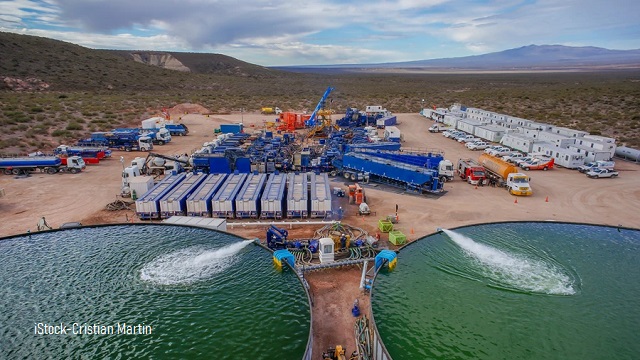Why Frackers Are Returning to Abandoned Oil Patches in Droves

For consumers, high oil prices are a headache; for drillers, they are an opportunity.
Less than two years after the price of oil briefly plummeted to roughly negative $37 a barrel, an oil boom is underway in America—even in places where drilling was all but abandoned two years ago.
“Private oil producers are leading an industry return to places like the Anadarko Basin of Oklahoma and the DJ Basin in Colorado, where drilling had almost completely stopped in mid-2020,” reports The Wall Street Journal.
The Anadarko Basin, for example, has surged from just seven active drilling rigs to 46, according to energy analytics firm Enverus, while the DJ Basin in Colorado saw its number of active rigs jump from four to 15. Meanwhile, Utah’s Uinta Basin and the Powder River Basin in Wyoming, which both saw active rigs fall to zero in 2020, have seen rigs increase to roughly a dozen.
.@wsj: Frackers Push Into Once-Dead Shale Patches as Oil Nears $100 a Barrel. Oil producers drill in less-desirable areas like Anadarko Basin of Oklahoma and DJ Basin of Colorado, where activity virtually stopped during pandemic https://t.co/b1Ipx2lD3s #energy
— Amb Antonio Garza (@aogarza) February 21, 2022
‘It Feels Great’
What is driving frackers back to abandoned oil patches? It’s not newly discovered shale oil. Rather, it’s high oil prices.
The price of oil has surged in recent months, increasing from roughly $65 a barrel to the low-to-mid $90s in recent weeks. (The price of crude closed at just under $94 a barrel Monday.) The prices—which recently hit a seven-year high—are attracting drillers to shale patches that are more expensive to drill and thus require higher prices to be profitable.
For consumers, high oil prices can be a headache, because they result in higher gasoline prices. But for drillers, high oil prices mean more potential for profit.
Klee Watchous, president of the Kansas-based company Palomino Petroleum, says the higher prices have marked a turnaround for his small company and the surrounding communities where it operates.
“After many years of fighting this low oil-price situation, it feels great,” Watchous told the WSJ. “The cycles of boom and bust have been part of the oil-and-gas industry for decades, and no one knows how long it will last.”
Watchous is looking to seize on the higher prices to venture into Illinois in 2022, a state few companies have sought to tap in recent years.
A Lesson on Prices
Some might begrudge oil companies like Palomino profiting from high oil prices, but it’s precisely their desire for profits that can help tame surging oil prices. As oil companies expand their production, they increase the supply of oil, which inevitably puts a downward pressure on prices. It’s a perfect example of Adam Smith’s insight that free markets harness the self-interest of individuals to serve the whole.
“Every individual… neither intends to promote the public interest, nor knows how much he is promoting it… he intends only his own security,” Smith explained in The Theory of Moral Sentiments; “and by directing that industry in such a manner as its produce may be of the greatest value, he intends only his own gain, and he is in this, as in many other cases, led by an invisible hand to promote an end which was no part of his intention.”
High prices do two important things in an economy. First, they encourage people to conserve scarce resources. Many people love steak and lobster, but few of us eat it every week or every month because it’s quite expensive. In other words, the high price discourages us from demanding steak and lobster. But that’s not the only function of the high price. It also encourages lobster trappers and beef companies to bring more of these products to market in pursuit of profit. Together, these two mechanisms help make scarce resources more abundant.
Price is arguably the simplest and most vital principle in economics. It signals both scarcity (to consumers) and opportunity (to entrepreneurs). Yet the economist Thomas Sowell has noted the importance of prices is often misunderstood by activists and politicians.
“Prices play a crucial role in determining how much of each resource gets used where and how the resulting products get transferred to millions of people,” Sowell wrote in Basic Economics. “Yet this role is seldom understood by the public and it is often disregarded entirely by politicians.”
Unintended Consequence of High Prices?
It’s worth noting that the word “price” never appeared in President Joe Biden’s 2020 executive order killing the Keystone XL Pipeline, an oil pipeline system between Canada and the US commissioned in 2010.
Nixing the 1,700-mile pipeline, which could have carried roughly 800k barrels of oil a day from Alberta to the Texas Gulf Coast, did nothing to reduce the pain at the pump consumers are feeling today, with gasoline currently at more than $3.50 a gallon. But that was expected.
What perhaps was unexpected was that higher prices would result in additional fracking—a process many contend is harder on the environment than regular drilling, and a practice Biden has said he wants to “move gradually away from.”
So while the role prices play in an economy is one of the most basic lessons in economics, politicians of every stripe would do well to remember one of the greatest fallacies: overlooking secondary consequences.
COLUMN BY
Jon Miltimore
Jonathan Miltimore is the Managing Editor of FEE.org. His writing/reporting has been the subject of articles in TIME magazine, The Wall Street Journal, CNN, Forbes, Fox News, and the Star Tribune. Bylines: Newsweek, The Washington Times, MSN.com, The Washington Examiner, The Daily Caller, The Federalist, the Epoch Times.
RELATED ARTICLE: Oil Soars Beyond $100 Per Barrel For The First Time Since 2014
EDITORS NOTE: This FEE column is republished with permission. ©All rights reserved.

